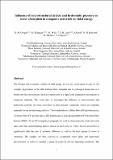| dc.contributor.author | Grogan, D.M. | |
| dc.contributor.author | Flanagan, M. | |
| dc.contributor.author | Walls, M. | |
| dc.contributor.author | Leen, Sean B. | |
| dc.contributor.author | Harrison, Noel M. | |
| dc.contributor.author | Mamalis, D. | |
| dc.contributor.author | Goggins, Jamie | |
| dc.date.accessioned | 2019-12-02T16:05:33Z | |
| dc.date.available | 2019-12-02T16:05:33Z | |
| dc.date.issued | 2018-01-06 | |
| dc.identifier.citation | Grogan, D., Flanagan, M., Walls, M., Leen, S., Doyle, A., Harrison, N., Mamalis, D., Goggins, J. (2018). Influence of microstructural defects and hydrostatic pressure on water absorption in composite materials for tidal energy. Journal of Composite Materials, 52(21), 2899–2917. https://doi.org/10.1177/0021998318755428 | en_IE |
| dc.identifier.issn | 1530-793X | |
| dc.identifier.uri | http://hdl.handle.net/10379/15606 | |
| dc.description.abstract | The lifespan and economic viability of tidal energy devices are constrained, in part, by the complex degradation of the tidal turbine blade materials due to prolonged immersion in a hostile sub-sea environment. Seawater penetration is a significant degradation mechanism in composite materials. This work aims to investigate the influence of microstructure and hydrostatic pressure on water absorption in four polymer composites which are candidate materials for use in tidal energy devices. These materials are: a glass fibre powder epoxy, a carbon fibre powder epoxy, glass fibre Ampreg epoxy and a chopped fibre glass fibre Polyether Ether Ketone. X-ray computed tomography is used to characterise the voids, resin-rich areas and other manufacturing defects present in each material. These defects are known to significantly alter the rate of moisture diffusion, as well as the total uptake of water at saturation. The samples are then exposed to accelerated water aging and hydrostatic pressurisation in order to simulate a range of expected sub-sea operating conditions. The material micro-structure, the matrix material and pressurisation level are shown to strongly influence both the moisture absorption rate and total water uptake. Significant volumetric changes are also noted for all samples, both during and after aging. X-ray computed tomography scans of specimens also provide a unique insight into the role of voids in storing water once a material has reached saturation. | en_IE |
| dc.description.sponsorship | The author(s) disclosed receipt of the following financial support for the research, authorship, and/or publication of this article: This research was partly funded by Science Foundation Ireland (SFI) through the Marine and Renewable Energy Ireland (MaREI) research centre (Grant no. 12/RC/2302), the Irish Research Council (IRC) through the employment-based postgraduate scheme and by MARINCOMP – Novel Composite Materials and Processes for Marine Renewable Energy (EU FP7 – People, Industry Academia Partnerships and Pathways (IAPP), reference: 612531). The last author would like to acknowledge the support of Science Foundation Ireland through the Career Development Award programme (Grant No. 13/CDA/2200). | en_IE |
| dc.format | application/pdf | en_IE |
| dc.language.iso | en | en_IE |
| dc.publisher | SAGE Publications | en_IE |
| dc.relation.ispartof | Journal Of Composite Materials | en |
| dc.rights | Attribution-NonCommercial-NoDerivs 3.0 Ireland | |
| dc.rights.uri | https://creativecommons.org/licenses/by-nc-nd/3.0/ie/ | |
| dc.subject | Polymer composites | en_IE |
| dc.subject | tidal turbine blade | en_IE |
| dc.subject | water aging | en_IE |
| dc.subject | X-ray computed tomography | en_IE |
| dc.subject | ocean energy | en_IE |
| dc.subject | manufacturing defects | en_IE |
| dc.subject | composite voids | en_IE |
| dc.subject | MECHANICAL-PROPERTIES | en_IE |
| dc.subject | MOISTURE ABSORPTION | en_IE |
| dc.subject | DESIGN METHODOLOGY | en_IE |
| dc.subject | DAMAGE | en_IE |
| dc.subject | BEHAVIOR | en_IE |
| dc.subject | DIFFUSION | en_IE |
| dc.subject | STRENGTH | en_IE |
| dc.title | Influence of microstructural defects and hydrostatic pressure on water absorption in composite materials for tidal energy | en_IE |
| dc.type | Article | en_IE |
| dc.date.updated | 2019-11-26T18:04:56Z | |
| dc.identifier.doi | 10.1177/0021998318755428 | |
| dc.local.publishedsource | https://doi.org/10.1177/0021998318755428 | en_IE |
| dc.description.peer-reviewed | peer-reviewed | |
| dc.contributor.funder | Science Foundation Ireland | en_IE |
| dc.contributor.funder | Irish Research Council | en_IE |
| dc.contributor.funder | Seventh Framework Programme | en_IE |
| dc.internal.rssid | 15346244 | |
| dc.local.contact | Sean Leen, Mechanical & Biomedical Eng, Eng-2051, New Engineering Building, Nui Galway. 5955 Email: sean.leen@nuigalway.ie | |
| dc.local.copyrightchecked | Yes | |
| dc.local.version | ACCEPTED | |
| dcterms.project | info:eu-repo/grantAgreement/SFI/SFI Research Centres/12/RC/2302/IE/Marine Renewable Energy Ireland (MaREI) - The SFI Centre for Marine Renewable Energy Research/ | en_IE |
| dcterms.project | info:eu-repo/grantAgreement/EC/FP7::SP3::PEOPLE/612531/EU/Novel Composite Materials and Processes for Offshore Renewable Energy/MARINCOMP | en_IE |
| dcterms.project | info:eu-repo/grantAgreement/SFI/SFI Career Development Award/13/CDA/2200/IE/Achieving nearly zero energy buildings - A life cycle assessment approach to retrofitting existing buildings (acronym: nZEB-RETROFIT)/ | en_IE |
| nui.item.downloads | 356 | |


